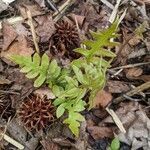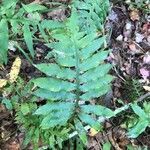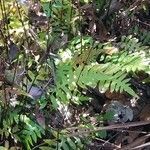Rhizome 2–3.5 mm thick; lvs dimorphic, 3–8 dm, the sterile ones with stramineous petiole and deltoid-ovate blade 10–17 cm wide, deeply pinnatifid or nearly pinnate at the base, the segments 7–10 pairs, 1–2 cm wide, finely serrulate, net-veined with several series of areoles, but the veins free at the margin; fertile lvs surpassing the sterile, with shining, purple-black petiole, the segments narrowly linear, with a single series of areoles along the costa; indusia linear, 4–8 mm, opening tardily and not reflexed in age; 2n=70. Swamps and wet woods in acid soil; N.S. to n. Fla., w. to Mich., Mo., and e. Tex., commonest on the coastal plain. (Lorinseria a.)
A fern.




